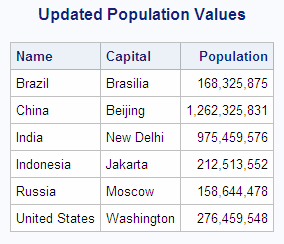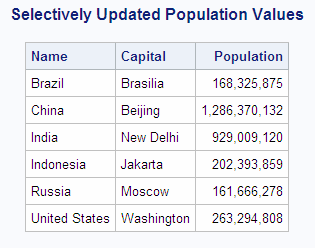Updating Data Values in a Table
You can use the UPDATE statement to modify
data values in tables and in the tables that underlie PROC SQL and
SAS/ACCESS views. For more information about updating views, see
Updating a View. The UPDATE statement updates data in existing columns; it
does not create new columns. To add new columns, see Altering Columns and Creating New Columns. The examples in this section update the original NEWCOUNTRIES
table.
Updating All Rows in a Column with the Same Expression
/* code for all examples in updating section */
libname sql 'SAS-library';
proc sql;
delete from sql.newcountries;
insert into sql.newcountries
select * from sql.countries
where population ge 130000000;
Updating Rows in a Column with Different Expressions
If you want
to update some, but not all, of a column's values, then use a WHERE
expression in the UPDATE statement. You can use multiple UPDATE statements,
each with a different expression. However, each UPDATE statement can
have only one WHERE clause. The following UPDATE statements result
in different population increases for different countries in the NEWCOUNRTRIES
table.
libname sql 'SAS-library';
proc sql;
delete from sql.newcountries;
insert into sql.newcountries
select * from sql.countries
where population ge 130000000;proc sql;
update sql.newcountries
set population=population*1.05
where name like 'B%';
update sql.newcountries
set population=population*1.07
where name in ('China', 'Russia');
title "Selectively Updated Population Values";
select name format=$20.,
capital format=$15.,
population format=comma15.0
from sql.newcountries;You can accomplish the
same result with a CASE expression:
update sql.newcountries
set population=population*
case when name like 'B%' then 1.05
when name in ('China', 'Russia') then 1.07
else 1
end;If the WHEN clause is true, then the corresponding
THEN clause returns a value that the SET clause then uses to complete
its expression. In this example, when Name starts with the letter B,
the SET expression becomes population=population*1.05.
CAUTION:
Make sure
that you specify the ELSE clause.
If you omit the ELSE
clause, then each row that is not described in one of the WHEN clauses
receives a missing value for the column that you are updating. This
happens because the CASE expression supplies a missing value to the
SET clause, and the Population column is multiplied by a missing value,
which produces a missing value.
Handling Update Errors
While you are updating or inserting rows in a table,
you might receive an error message that the update or insert cannot
be performed. By using the UNDO_POLICY= option, you can control whether
the changes that have already been made will be permanent.
The UNDO _POLICY= option
in the PROC SQL and RESET statements determines how PROC SQL handles
the rows that have been inserted or updated by the current INSERT
or UPDATE statement up to the point of error.
Note: Alternatively, you can set
the SQLUNDOPOLICY system option. For more information,
see SQLUNDOPOLICY= System Option.
Copyright © SAS Institute Inc. All rights reserved.

